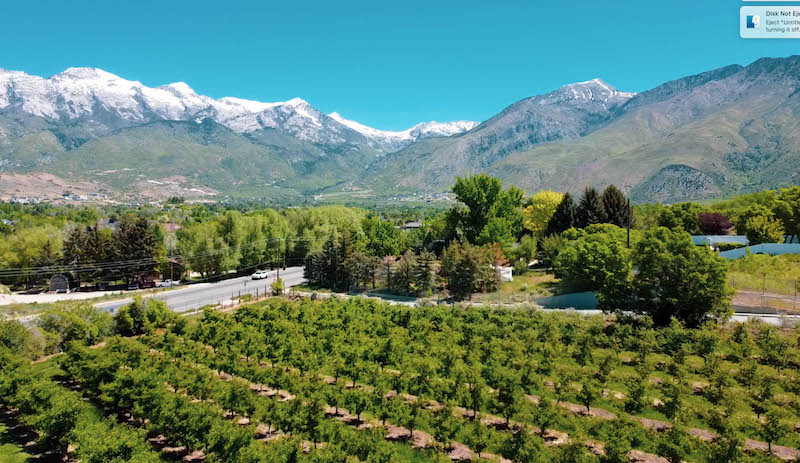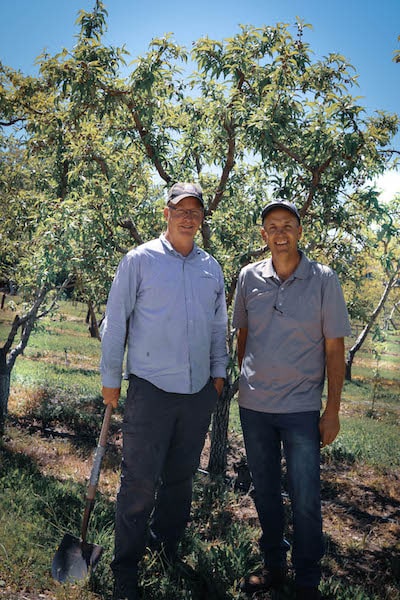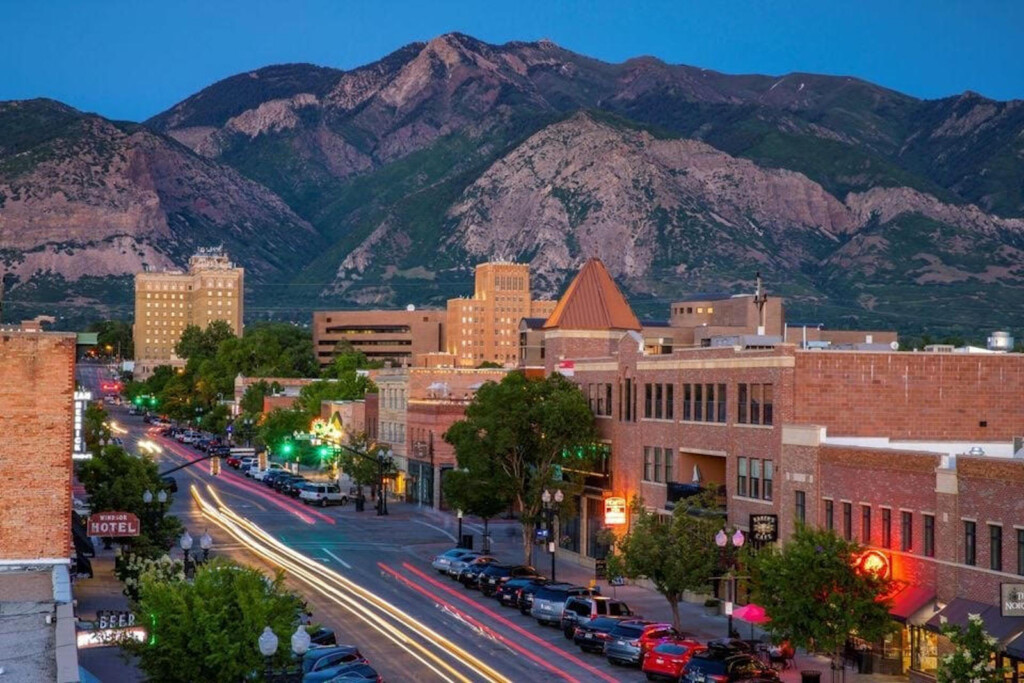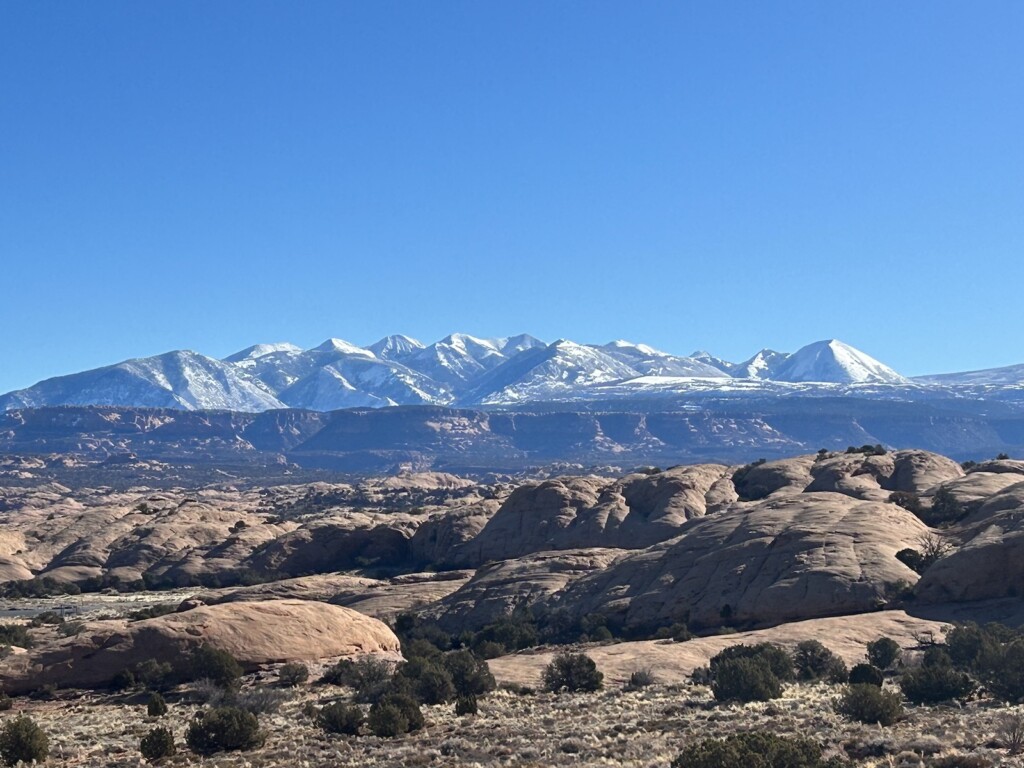
Clark Burgess is in an animated conversation with Curtis Rowley concerning the repair of an oil pump in the Foothills of Alpine, Utah. These are two farmers who love what they do, but practice their fruit growing in very different scales of operation: Burgess on 10 acres; Rowley on 2,000 acres.
The flourishing apple trees in neat rows surrounded by the snow capped Timpanogos mountains make for one of the most idyllic settings of any farm in Utah. Burgess Farm is the last remaining orchard in the area, and has been in operation for the past 109 years.
Mormon Pioneers homesteaded, irrigated, and planted orchards. They named the surrounding towns Alpine, Highland and Lehi. The foothills along the Wasatch Front have always had just the right amount of precipitation, and along with the cold evenings and hot summers, just the right amount of stress to provide amazing fruit.

But too frequently, there are late spring freezes which can destroy an entire crop. In Burgess’ father’s first three years here, he experienced three crop-destroying freezes in a row. Due to this, the Burgess family never became full-time farmers, but always maintained their orchards part-time. “My job at the Utah Department of Agriculture provided both steady income and crop insurance,” he says.
Recently, the world has surrounded the sleepy town of Alpine. Just ten miles to the west is Lehi — the epicenter of “Silicon Slopes”, where tech companies are popping up like weeds. First, there was just IM Flash; later Oracle, then Vivant, Qualtrics, now Adobe and Podium, and at least a few dozen others line the I-15 corridor and are jumbled around Traverse Mountain in a haphazard manner. The Timpanogos Highway was once a narrow two-lane road. Now it’s a six-lane highway.
The tech world has planted roots here, bringing with it high-paying jobs and transplants from California, whose salaries can afford them palatial homes. Just around the corner from Burgess Orchard are $1 million to $3 million-dollar mansions. Since the former farmland has such amazing mountain views, the tech world titans love buying acres of farmland with their millions, thus drastically increasing real estate prices in the process, and forcing farmers to reconsider the economics of their operations.

For Burgess, the demand for his fruit, sold from his fruit stand store on the west of his property, has never been better. But, Burgess says, this is exactly his problem. “They were lining up around the street,” he said. “We sold out of our peaches in one day,” adding, “We started handing out numbers, and we would be sold out in an hour. Then we started selling peach ice cream and they all went crazy over that.” The long hours and huge demand didn’t exactly feel like retirement any longer.
Just a few years ago, Burgess retired from his position at the Utah Department of Agriculture, and hoped to farm part-time, using hired help to do most of the work so he could enjoy his leisure time. But after his long-time farm hand fell off a ladder and was injured, he said, “I didn’t have anyone else, and I had 10 acres of peaches to thin.”
Burgess hired many college students, who, he said, “were kind of helpful. Sort of.” But there is skill involved, and many college kids don’t appreciate the difficulty of manual labor. Last season, he did find some workers, but it was simply too much work for mostly just himself and his wife, both of whom are now in their late fiftues.

“I reached out to everyone I knew to get help,” which is where Curtis Rowley came into the picture. The Rowley Family, consisting of several families, are the owners of Cherry Hill Farms and the Rowley Red Barn Store and cidery in Santaquin, 40 miles south, where real estate is not as insanely hot.
The Rowley’s are now in their fourth generation of farming mostly apples and peaches on 1,000 acres in Utah, and another 1,000 acres in Idaho. It’s quite a step up from the ten acres where Burgess currently resides. Rowley employs dozens of H2B as well as permanent staff to maintain his farms, and stepped up when Burgess was in need.
“They could do in one day what would take me at least one week,” said Burgess. The mostly immigrant-workforce get room, board, good pay, and transportation paid for under the immigrant-visa program. This year Rowley is leasing Burgess’ farm and fruit stand, where he and his staff will manage all farm operations as well as the sales at the stand.
But sadly, this will likely be the final year of the Burgess Orchard. “I’m already starting to take offers on the property,” he said.

With the land fetching around $1 million per acre or more, Burgess and his children are realizing that the enormous difficulty of maintaining operations compared to the enormous ease of enjoying a small fortune is a bit difficult to pass up.
MORE ABOUT UTAH FARMS AND ORCHARDS
Ferguson Fruit Orchard
Woodyatt’s Montmorency Cherry Orchard: Tart Cherries Make a Sweet Business
Perry, Utah – Tagge Farm
Suburban Sprawl in Utah– its effect on Utah Farmers
Peaches or Patios: Suburbs Pressure American Fork Land
Cash or Crops?
Subscribe to Utah Stories weekly newsletter and get our stories directly to your inbox





